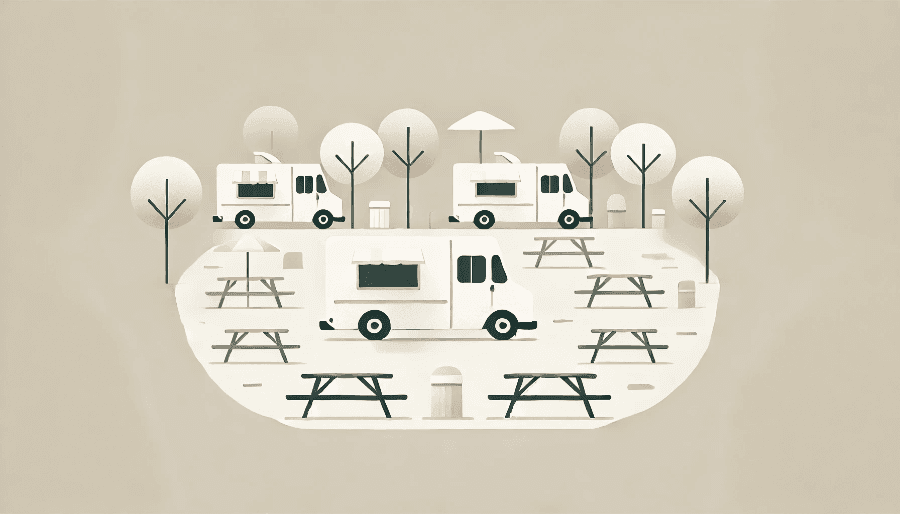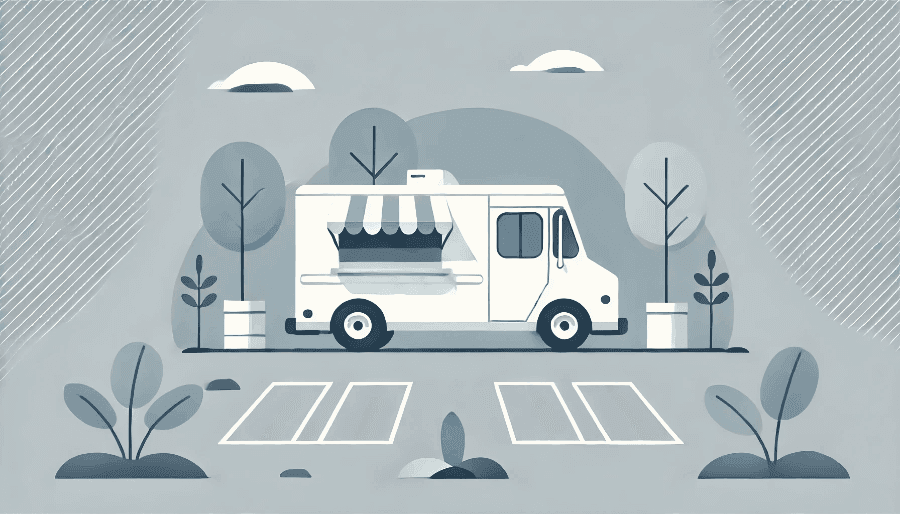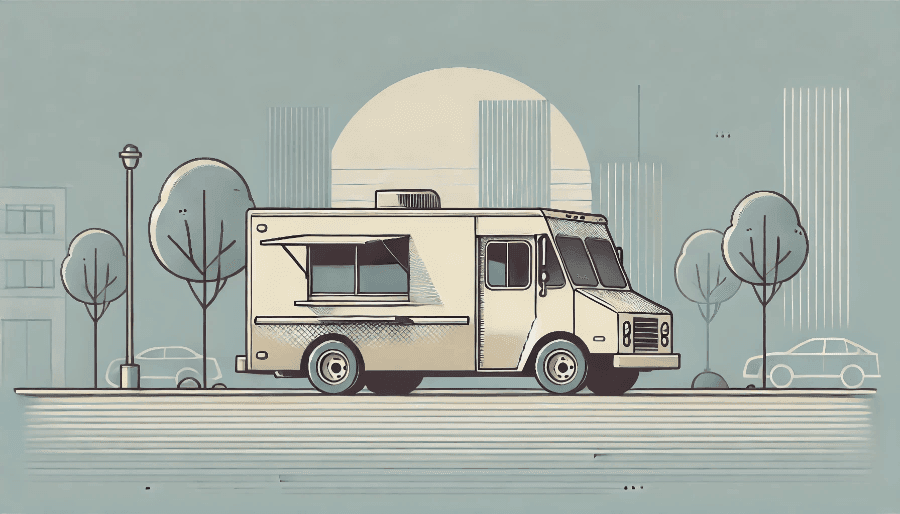 Imagine transforming a simple piece of land into a buzzing social hotspot where delicious aromas fill the air, and people gather to enjoy mouth-watering meals from their favorite food trucks. Food truck parks have become a popular trend, offering a unique dining experience and fostering a sense of community. But the secret to their success lies in a well-thought-out food truck park design. In this post, we'll guide you through the essential elements of designing a food truck park that not only attracts visitors but keeps them coming back for more.
Imagine transforming a simple piece of land into a buzzing social hotspot where delicious aromas fill the air, and people gather to enjoy mouth-watering meals from their favorite food trucks. Food truck parks have become a popular trend, offering a unique dining experience and fostering a sense of community. But the secret to their success lies in a well-thought-out food truck park design. In this post, we'll guide you through the essential elements of designing a food truck park that not only attracts visitors but keeps them coming back for more.
Understanding the Basics of Food Truck Park Design
Before diving into the nitty-gritty details, it's essential to grasp the fundamentals of food truck park design. At its core, a food truck park is a designated area where multiple food trucks can park and serve customers in a communal setting. The goal is to create a space that is functional for the food truck operators and inviting for the patrons.
Key Elements of Successful Food Truck Park Design:
-
Location and Accessibility: The location of your food truck park plays a crucial role in its success. It should be easily accessible to both foot traffic and vehicles. Proximity to popular areas, like downtown districts or near office complexes, can draw more visitors.
-
Layout and Spacing: Proper layout and spacing are vital to ensure smooth operation. Trucks need enough room to park and set up, and there should be ample space for customers to move around comfortably. A cluttered or cramped design can detract from the overall experience.
-
Amenities and Services: Essential amenities, such as seating areas, restrooms, and waste disposal facilities, enhance the customer experience. Consider including shaded areas and weather protection to make the park more comfortable year-round.
-
Aesthetic Appeal: The visual aspect of your food truck park can significantly impact its attractiveness. Thoughtful landscaping, attractive lighting, and well-designed signage can create an inviting atmosphere that encourages people to visit and stay longer.
By focusing on these core elements, you can lay the foundation for a food truck park design that is both practical and appealing. In the next sections, we'll dive deeper into the specific aspects of planning, creating an inviting atmosphere, ensuring practicality and compliance, and promoting your food truck park.
Planning Your Food Truck Park Layout
When it comes to food truck park design, the layout is key. A well-planned layout not only facilitates smooth operations for food truck vendors but also enhances the overall customer experience.
Emphasizing Food Truck Park Design Principles:
-
Flow and Movement: Design your park to allow easy movement for both trucks and customers. Consider creating wide pathways that can handle high foot traffic and ensure that trucks can easily enter and exit the park.
-
Central Gathering Areas: Designate central areas for seating and socializing. These areas should be easily accessible from all trucks and include a mix of seating options, such as picnic tables, benches, and casual lounge areas.
-
Zoning for Different Functions: Divide your park into distinct zones for different purposes. For instance, have a designated dining area, a space for entertainment or live music, and a separate zone for restrooms and waste disposal. This zoning helps in organizing the space efficiently and keeping it visually appealing.
Optimal Spacing and Arrangement:
-
Truck Placement: Arrange trucks in a way that maximizes visibility and accessibility. A circular or semi-circular layout can be effective, allowing customers to easily browse all options. Ensure there is enough space between trucks for queuing and for trucks to set up their serving stations.
-
Customer Pathways: Design clear pathways that guide customers through the park. Avoid dead ends and ensure pathways are wide enough to accommodate crowds, especially during peak hours.
Incorporating Essential Amenities:
-
Seating Areas: Provide ample seating close to the food trucks but not obstructing customer flow. Consider different types of seating to cater to various preferences, including shaded areas for comfort during hot weather.
-
Restrooms: Ensure restrooms are easily accessible and well-maintained. Clean and convenient restrooms can significantly enhance the customer experience.
-
Waste Disposal: Strategically place trash and recycling bins throughout the park. Encourage proper waste disposal to maintain cleanliness and hygiene.
By carefully planning the layout and incorporating essential amenities, you can create a food truck park design that is both functional and inviting, making it a favorite destination for food lovers.
Creating an Inviting Atmosphere
A successful food truck park is more than just a place to grab a quick bite; it's a destination where people come to relax, socialize, and enjoy the ambiance. Creating an inviting atmosphere is crucial to attracting and retaining visitors.
Enhancing Aesthetic Appeal:
-
Landscaping: Use landscaping to add greenery and natural beauty to your food truck park. Trees, shrubs, and flower beds can create a pleasant environment and provide much-needed shade during sunny days.
-
Lighting: Good lighting is essential for creating a safe and welcoming atmosphere, especially in the evenings. String lights, lanterns, and spotlights can add a festive and cozy feel to the park.
-
Signage: Attractive and clear signage helps guide visitors and adds to the park’s visual appeal. Use creative and themed signs to give your park a unique identity and make it easy for customers to find their way around.
Adding Features for Engagement:
-
Live Music and Entertainment: Incorporate a stage or designated area for live music and entertainment. Regular performances can draw crowds and create a lively atmosphere.
-
Community Events: Host community events such as farmers' markets, craft fairs, or themed food festivals. These events can attract new visitors and encourage repeat visits.
-
Interactive Elements: Include interactive elements like art installations, playgrounds for kids, or photo-op spots. These features can enhance the overall experience and make your park a favorite hangout spot.
Creating Comfortable Spaces:
-
Shaded Areas: Provide shaded seating options to protect customers from the sun. Consider installing umbrellas, canopies, or pergolas.
-
Weather Protection: Design areas that can offer shelter during rain or extreme weather. Covered seating and sheltered walkways can ensure that your park remains a comfortable destination in all weather conditions.
-
Cozy Nooks: Create small, cozy nooks or corners where visitors can relax away from the main hustle and bustle. These areas can be great for families or individuals looking for a quieter spot to enjoy their meal.
By focusing on aesthetics, engagement, and comfort, you can design a food truck park that not only draws visitors in but keeps them coming back for the inviting and enjoyable experience it offers.
Ensuring Practicality and Compliance
Designing a food truck park isn’t just about aesthetics and layout; it also requires careful attention to practicality and compliance with local regulations. Ensuring that your park operates smoothly and meets all legal requirements is essential for long-term success.
Addressing Food Truck Parking Regulations and Permits:
-
Local Zoning Laws: Familiarize yourself with local zoning laws to ensure that your food truck park is in a permissible location. Some areas may have specific zones designated for commercial activities like food truck parks.
-
Permits and Licenses: Obtain all necessary permits and licenses required to operate a food truck park. This might include health permits, business licenses, and special event permits, depending on your local regulations.
-
Health and Safety Standards: Ensure that your food truck park complies with health and safety standards. This includes providing adequate sanitation facilities, adhering to fire safety codes, and ensuring that food trucks meet health department requirements.
Ensuring Adequate Utility Hookups:
-
Electricity: Provide reliable electrical hookups for food trucks to power their equipment. Consider installing dedicated power stations with sufficient voltage to meet the needs of multiple trucks.
-
Water Supply: Ensure that there is a clean and accessible water supply for food trucks. This is particularly important for trucks that require water for cooking and cleaning.
-
Waste Disposal: Implement a robust waste management system. Provide ample trash bins and recycling stations, and schedule regular waste collection to keep the park clean and hygienic.
Safety and Health Considerations:
-
Fire Safety: Install fire safety equipment, such as fire extinguishers and fire blankets, throughout the park. Ensure that all food trucks have their own fire safety measures in place.
-
Emergency Access: Design the park layout to allow easy access for emergency vehicles. Ensure that pathways are wide enough and that there are clear routes for quick evacuation if necessary.
-
Cleanliness: Regularly maintain and clean common areas, restrooms, and seating areas. A clean environment is crucial for the health and satisfaction of your visitors.
By addressing these practical and compliance aspects, you can create a food truck park that operates smoothly, meets all legal requirements, and provides a safe and enjoyable experience for both vendors and visitors.
Promoting Your Food Truck Park
Once your food truck park is designed and ready to go, the next step is to attract visitors. Effective promotion can turn your park into a popular destination and ensure its ongoing success.
Strategies for Marketing Your Food Truck Park:
-
Social Media: Utilize social media platforms like Instagram, Facebook, and Twitter to promote your food truck park. Share photos, updates, and event announcements to engage with your audience and build excitement.
-
Local Advertising: Take advantage of local advertising opportunities, such as community bulletin boards, local newspapers, and radio stations. Partner with local businesses to cross-promote and reach a broader audience.
-
Online Presence: Create a dedicated website for your food truck park. Include essential information such as location, operating hours, event schedules, and a list of participating food trucks. Optimize your website for search engines to attract more visitors.
Partnering with Popular Food Trucks:
-
Collaborations: Partner with well-known food trucks to draw their loyal customers to your park. Feature a rotating lineup of popular trucks to keep the offerings fresh and exciting.
-
Exclusive Events: Host exclusive events or special promotions with popular food trucks. This can create buzz and attract a larger crowd.
Utilizing Community Events and Festivals:
-
Event Hosting: Host community events, such as food festivals, live music performances, and themed nights. These events can attract diverse crowds and increase the visibility of your food truck park.
-
Collaborate with Local Organizations: Partner with local organizations, such as schools, non-profits, and businesses, to host joint events. This can help you tap into different community segments and build strong local connections.
Conclusion
Designing a food truck park is an exciting opportunity to create a unique community space where people can enjoy a variety of culinary delights. By focusing on the essential elements of food truck park design, planning a functional and appealing layout, creating an inviting atmosphere, ensuring practicality and compliance, and promoting your park effectively, you can turn your vision into a thriving reality.
A well-designed food truck park not only benefits the food truck operators but also provides a vibrant and enjoyable experience for visitors. From choosing the right location and amenities to adding aesthetic touches and engaging features, every detail matters in creating a space that people will love to visit.
Let FoodParks Help
Are you a landowner with food truck parking? Don't miss out on the opportunity to transform your space into a bustling food truck park. List your food truck parking on FoodParks and become part of a growing community dedicated to culinary diversity and community engagement. With FoodParks, you can connect with popular food trucks, attract a steady stream of visitors, and turn your land into a vibrant social hub.
Join the movement today! Create your listing and start your journey towards creating an amazing food truck park. Your land has the potential to be the next favorite destination for food lovers in your area. Let's make it happen together!


